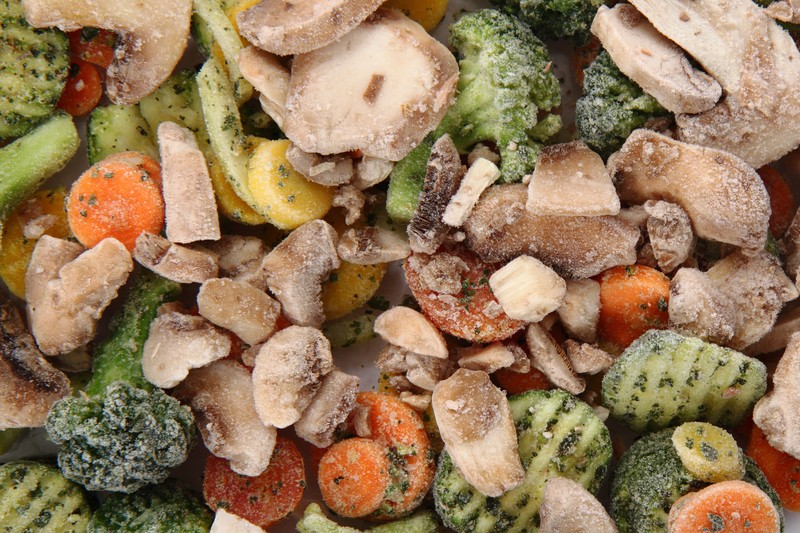Freezing delays the growth of bacteria and slows the work of enzymes, which keeps your fruits and vegetables preserved. Just a note: Be sure to wash/clean all foods before prepping for freezing.
Produce that does well sliced or diced
Bell peppers, avocado, mango, pineapple, melon, peas, carrots, broccoli, cauliflower, stone fruits (peaches, nectarines, plums, cherries), apples (yes, you can freeze apples!), summer squash, and winter squash.
Cut broccoli and cauliflower into florets. Shell peas, trim the ends of green beans and asparagus. Dice or slice peeled carrots, squash, brussels sprouts, and large leaves of spinach, chard, and kale. Rhubarb should be trimmed of woody ends and diced.Potatoes can be frozen, but benefit from being shredded. Think: hashbrowns. (Note: I personally don’t like freezing potatoes at home. The quality just isn’t as good.) Zucchini is another veggie with a high water content. It can be sliced or diced and frozen, but I prefer shredding it instead.
Corn and bananas are pretty versatile when it comes to freezing. Corn can be frozen whole or cut from the cob. It’s totally up to you! I think it’s one of the best veggies for freezing because the quality isn’t as affected by the cold temperatures.
Bananas can be frozen whole and unpeeled, or peeled and whole, or peeled and cut. They’re pretty fabulous that way! I can’t resist adding a frozen banana to my daily smoothie to sweeten it up without adding sugar.
After fruits and veggies have been peeled, sliced and diced, as needed, there are a few more preparation steps.Most vegetables also need to be blanched before freezing.
Blanching is nothing more than plunging vegetables into a pot of boiling water, letting them cook briefly (3-4 minutes max), and transferring them to a big bowl of ice water to stop the cooking. Why is this important? Remember that mushiness I mentioned earlier? This will help with that, but it also helps maintain the color and nutrients, as well as killing any surface organisms that could lead to spoilage.Corn (though you could), tomatoes, onions, potatoes (including sweet), and winter squash don’t need to be blanched. And neither do fruits.
Leafy greens don’t have to be cooked, but they can be. But one thing is for sure, quickly sauteing spinach, for instance, really saves on space! Pictured above is four ounces of spinach cooked and fresh.
How to: Pureed Spinach Cubes for Green Smoothies
Something I saw a few months ago (and a few of you lovely readers mentioned to me) that I think is brilliant, is making spinach ice cubes to add to smoothies. I usually just put the greens into my smoothie packs, but I finally tried this and I’m hooked! Simply add a whole bunch of leafy greens to a blender with enough water to make a smooth puree and freeze. Easy peasy!I also like to roast some foods before I freeze them. I’ve done this with tomatillos, plums, tomatoes, and peppers. I will either puree them into a sauce or freeze them as is, juices and all.
Labeling an Storing:
You’ll want to label the bags and containers with the date and the contents. You might think you’ll remember what it is, but six months down the road it might be more difficult to remember what was in each bag or container.Freezer tape will stay on the containers despite the cold temperature and the moisture. I like to run tape around the containers too, to keep out air and prevent hoar frost. Wrapping bags and containers in foil and taping will also help with that.
I like to use resealable freezer bags a lot when I freeze produce. They’re easy and inexpensive. Secret #9: Both bags and containers should be packed full. Remove as much air as possible. A trick I learned is to use a straw to suck all of the air from the bag and then quickly close it.
For containers, removing air is a bit challenge without the help of a vacuum device. A vacuum sealer is definitely the way to go for long-term storage — both for bags and containers. It is worth the extra expense to purchase a device if you do a lot of freezing. Removing the extra air and sealing fruit and veggies individually in plastic packaging yields a lot better results than the freezer bags alone. (My grandma swears by it!)
When using containers, be sure to leave enough headspace to allow for the liquids to expand as it freezes.
STORAGE TIME & THAWING
Typically in a basic freezer, frozen fruits and veggies will last a very long time. As time passes, the food doesn’t become inedible, but the quality does deteriorate. If you plan on keeping frozen foods for a long time, a deep freeze might be a better bet as it has lower temperatures and is opened less often.
For more “secrets”, tips and tricks go on over to Design Mom. They give you more prepping hints and also let you know what fruits do best when frozen whole instead of sliced and diced.
One year we bought far too many caramel apples and ended up freezing them. We took them out when we wanted them, let them thaw – leaving them crisp and cold – and had wonderful treats for the following Summer!
Whatever way you freeze, enjoy yourself and think ahead!

When sealing ziplock bags use a sink full of water. Put the bag in the water and let the pressure from the water push the air out.